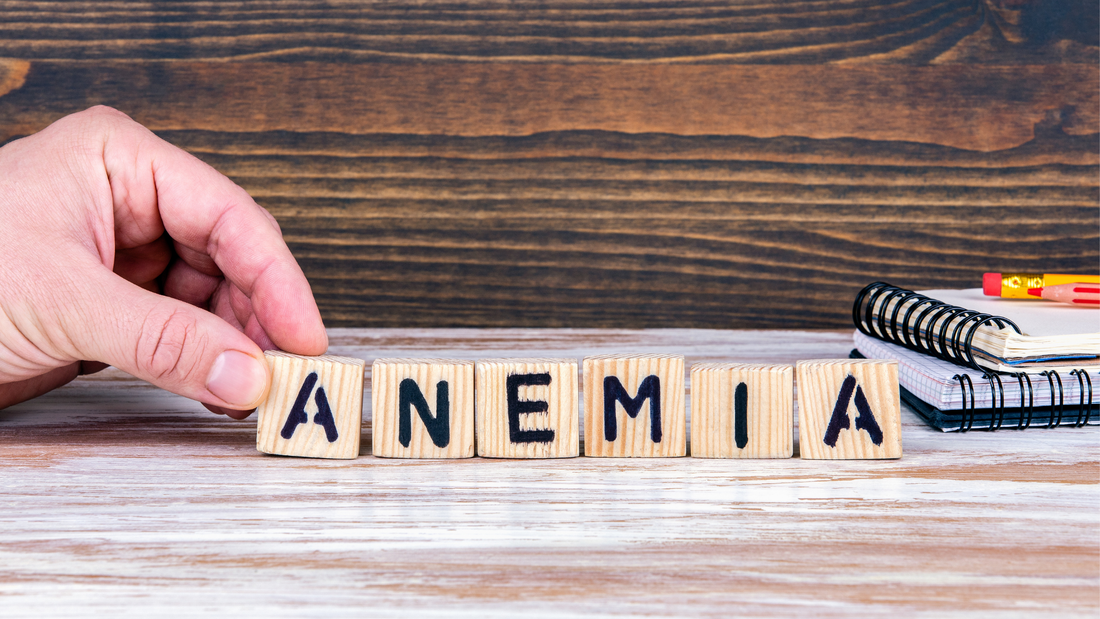
10 Natural Ways to Increase Hemoglobin and Combat Anemia
Naturally YoursShare

Gulping vitamin or mineral supplements might improve your nutritional status transiently. However, a balanced diet is a powerful toolkit that (where you include all your veggies, fruits, whole grains cereals, pulses, and nuts) will prevent you from nutritional deficiencies on a long-term basis.
So, the choice is yours either you can add healthy foods to your plate or iron pills to boost your hemoglobin level to combat anemia.
What is Anemia?
Anemia is a blood disorder that affects one-fourth of the world’s population. Women are most commonly affected by anemia than men due to menstrual blood losses.
Sometimes, we are not conscious of a low hemoglobin count. A blood examination is the only parameter through which you will get to know about your hemoglobin level.
The normal range of hemoglobin varies with age, gender, and medical conditions. The normal range of hemoglobin for non-pregnant non-lactating women is 12-15.5g/dl while for men is 13.5-17.5g/dl.
When the hemoglobin level of the individual falls below the normal range then he/she is considered anemic. Anemia occurs due to a decrease in red blood cells (RBC) count or low hemoglobin or improper functioning of the RBC.
Role of Hemoglobin in the blood
Hemoglobin is an iron-rich protein in the RBC which binds to the oxygen molecules in the lungs and delivers it to each and every cell of the body. After the release of oxygen, hemoglobin carries carbon dioxide from the body and delivers it to the lungs to exhale.
Thus, the transportation of gases like oxygen and carbon-dioxide depends on hemoglobin level and RBC count. Therefore, if your blood doesn’t have sufficient hemoglobin then your body may deprive of oxygen and you may feel tired, fatigued, shortness of breath, and pale skin.
Anemia is also distinguished according to the size of the cells, if cells are small then it is known as microcytic anemia and if cells are large then it is known as macrocytic anemia. Moreover, it is important to treat anemia before it causes any serious health complications.
Causes of anemia

In India, anemia is still an unsolved mystery that we are trying to solve from decades. The government has come through with various strategies yet it is prevalent in the Indian population.
1. There are different forms of anemia but iron-deficiency anemia is more predominant in India especially in women and children.
Pregnant women and children require special attention as iron-deficiency anemia in pregnant women may lead to serious complications whereas in children it affects language and motor skills. So, any kind of careless behavior may turn into a serious complication.
2. Anemia is caused due to deficiency of nutrients like iron deficiency, vitamin B12 deficiency and folic acid deficiency. These mentioned nutrients are essential for the production of hemoglobin and red blood cells in the bone marrow.
3. Underlying medical conditions such as thalassemia and bone marrow disorder are also responsible for causing anemia.
4. Altered dietary patterns and worst food combinations may also lead to nutritional deficiencies disorder like anemia. Drinking caffeinated drinks with meals hinder the absorption of iron or other nutrients
5. Genetic factors: Genetic disorders namely, sickle cell anemia, and auto-immune disorders where a breakdown of RBC takes place at a high rate.
Symptoms of Anemia
A blood examination is a confirmatory test where you get to know about hemoglobin status. But you can also notice it by consciously checking the symptoms that the body shows. The most common symptoms that our body shows are:
- Shortness of breath
- Pale skin, brittle nails and hair loss
- Fatigue and weakness
- Heartbeat rate increases
- Lack of stamina
- Poor appetite
- Headache, dizziness or tiredness
- Inflammation and soreness of the tongue
How can you manage anemia?
The main question arises is how can we counter the problem of anemia. So, you can increase your hemoglobin level either through a balanced meal or by taking tablets.
In severe cases, it is mandatory to take both iron-folic acid tablets along with food guidance.
Try to avoid consumption of tea, coffee, green tea and other caffeinated beverages along with major meals.
You can treat anemia by popping up iron pills but this will not fix the problem for a longer duration. Hence, mindful eating and inculcating iron-rich foods is the long-term approach that would boost your hemoglobin level.
Besides, a healthy diet will also provide you other crucial nutrients that are required for the proper functioning of the body.
Here are some iron-rich foods and home remedies that will foster your hemoglobin level and combat anemia.
1. Incorporation of iron-rich cereals, pulses and legumes, nuts and oilseeds

Below are some some foods with their iron content.
Cereals and cereal products
Rice, bran - 35 mg/100gm
Buckwheat (kuttu ka atta) - 15.5mg/100gm
Amaranth seeds (black) - 9.33gm/100gm
Quinoa - 7.51mg/100gm
Bajra - 6.42mg/100gm
Pulses and legumes
Bengal gram, roasted (bhuna chana) - 9.5mg/100gm
Peas, roasted - 6.4mg/100gm
Nuts and oilseeds
Niger seeds - 18.10-19.61mg/100gm
Garden cress - 17.2mg/100gm
Gingelly seeds - 13.9-15.04mg/100gm
Cashew nut - 5.95mg/100gm
Sunflower seeds - 5.85mg/100gm
2. Add more greens in your plate

Spinach, shalgam ka saag, ajmod patte, mustard greens, broccoli and cholai are good source of iron and add fiber in your diet also.
Raw spinach is high in oxalic acid so always try to eat cooked spinach as oxalic acid hinders the iron absorption and may also cause kidney stones problem.
3. Go for superfoods

Moringa is the best food option as it provides iron, Vitamin A, Vitamin C and magnesium in plentiful quantity.
Even, there are many types of researches that have shown that moringa supplementation reduces anemia in people. Regular consumption of moringa leaves aids in increasing the hemoglobin level and red blood cell numbers.
So, it is a magical food that you can incorporate into your meal plan in different ways. Even, you can add moringa leaves powder to make complementary feed for infants and children.
4. Fortify your iron-deficient or a low iron meal with iron-rich foods

You can go for iron-fortified foods available in the market like double fortified salt, iron fortified cereals, atta, pulses, rice etc. You can check fortified products by looking at the (+F) logo printed on the label.
Even, you can enrich your low iron foods by substituting a portion of food with iron rich foods like ragi, bara, moringa, sesame seeds, etc. For example, you can fortify your simple wheat flour by adding ragi, cholai, bajra and chana.
5. Food synergy

Try to combine foods that have synergistic effects means a combination of food increases the absorption of nutrients.
Vitamin C rich foods boost the absorption of iron as vitamin c is the carrier of iron. So, pick up foods high in vitamin C such as citrus fruits, papaya, guava, strawberries, grapefruits, bell pepper, gooseberries, and tomatoes. These foods may virtually improve your iron status.
6. Energize your morning with the goodness of dates and raisins.

Add a handful of raisins and 3-4 dates in your breakfast plan. This will offer you essential nutrients such as iron, magnesium, copper, Vitamin A, and Vitamin C and charges you for the whole day.
7. Iron-inhibitors

Phytates found in grains, legumes, nuts, vegetables, roots and fruits, and polyphenol like tannins in tea, coffee, herbs, and spices inhibit the iron absorption from food.
Therefore, it is always recommended not to take tea, coffee along with major meals.
8. Opt for effective processing of foods.

Following a quick processing idea could elevate the nutrient level of your foods such as soaking of dhal prior to cooking for a few hours or overnight would decrease the phytate level and other anti-nutritional agents.
Other processing methods like decortication, fermentation, germination and cooking improves the bioavailability of foods.
Germination of pulses for 48hours increases the ascorbic acid content and enhances the overall nutritional quality of food as well.
9. What to drink?

Rejuvenate your body by gulping down juices high in Vitamin C like aloe vera juice, beetroot juice, apple juice, amla juice, pineapple juice, orange juice, pomegranate juice and karonda juice.
Combining these juices with meals will increase the absorption of iron.
A simple recipe: you can prepare your own drink by combining ½ cup apple juice with ½ cup beetroot juice and add pinch of ginger, and mint leaves for extra flavor
10. Take a sip of herbal tea

Go for nettle tea, hibiscus tea, ginger lemon tea, mint tea, and shatavari tea as these herbal teas may be helpful in increasing the hemoglobin level.
Points to Ponder
A balanced diet is a possible solution to counter the problem of low hemoglobin where you include all your cereals, pulses, legumes, fruits & vegetables, and dry fruits in an adequate amount.
Iron-folic acid pills will temporarily manage anemia. However, if you want to solve the problem permanently then the dietary approach is the only way to tackle anemia or low hemoglobin.
ABOUT THE AUTHOR

Neha Singh, Msc(Hon.) Food and Nutrition
Neha is a sports nutritionist who loves to write on topics related to nutrition and encourage healthy eating for a wholesome lifestyle.
